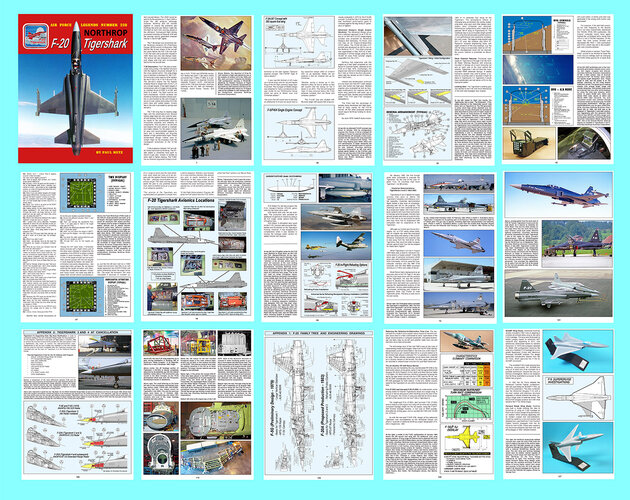- Joined
- 19 February 2007
- Messages
- 1,290
- Reaction score
- 2,204
NFAF-228 F-20 Tigershark
The books have landed at the sprawling world-wide Ginter Books headquarters and fulfillment center. Current orders will be going into shipping on 14 August.
With the loss of Specialty Press (currently in shutdown mode) as a US distributor, the best way for US-located persons to obtain the book is to go directly to the publisher at
http://www.ginterbooks.com/. Priced at $59.95, the book counts 144-pages, 296 color photos, 20 B&W photos, and 135 illustrations.

From the website:
The F-20 was conceived as the next evolution of the Fighter for Export (FX), a concept that had been in place for over 50 years and a formalized U.S. government policy for over 25 years. Northrop invested $1.2 billion of its own money on that policy. However, no production contract followed, not because of any technical deficiency but because of a changing government policy on what our allies would receive in U.S. military aid.
This book traces the development of the 3 generations of a 1955 design called the N-156 which became the T-38 and the F-5A/B. The F-5A/B evolved into the F-5E/F, the F-5G and finally the F-20 Tigershark. Each step in that progression was to keep up with the latest Soviet fighters. The F-20 was designed to counter the Mig-29 and Su-27, 4th generation fighters.
The book reveals the unique and triumphs to create a new type fighter in a world of design goals that produced a reliable, easily maintained, easy to fly, agile fighter-bomber that was affordable for many allied air forces in the wake of WW II. The story is told from the first person accounts ("Tigershark Voices") of the struggles increasingly complex, expensive and maintenance-intensive fighters. Other "Tigershark Voices" bring the reader into the F-5 and F-20 cockpits as the pilots describe flying this breed of fighters.
This definitive Tigershark book features original documents and photographs, most in color and previously unpublished. Original documents of USAF struggles to name the Tigershark the F-20, Presidential directives to build a fighter for export and limitations on sales, performance with no government funding are a few of the many examples of original documents pivotal to the F-20 story.
Also included are the various F-20 follow-on proposals: RF-20A/B, F-20B/C/E/F and Lavi fighters. As with all Ginter books, the F-20 Tigershark also presents information of interest to the scale modeler.
Beyond the detailed color photos, the book has many detailed factory drawings of the F-5 and F-20 with 3-views, cross section cuts and inboard drawings showing structure and equipment in great detail. The cockpit comparison drawings are masterpieces of the graphic arts.
The books have landed at the sprawling world-wide Ginter Books headquarters and fulfillment center. Current orders will be going into shipping on 14 August.
With the loss of Specialty Press (currently in shutdown mode) as a US distributor, the best way for US-located persons to obtain the book is to go directly to the publisher at
http://www.ginterbooks.com/. Priced at $59.95, the book counts 144-pages, 296 color photos, 20 B&W photos, and 135 illustrations.

From the website:
The F-20 was conceived as the next evolution of the Fighter for Export (FX), a concept that had been in place for over 50 years and a formalized U.S. government policy for over 25 years. Northrop invested $1.2 billion of its own money on that policy. However, no production contract followed, not because of any technical deficiency but because of a changing government policy on what our allies would receive in U.S. military aid.
This book traces the development of the 3 generations of a 1955 design called the N-156 which became the T-38 and the F-5A/B. The F-5A/B evolved into the F-5E/F, the F-5G and finally the F-20 Tigershark. Each step in that progression was to keep up with the latest Soviet fighters. The F-20 was designed to counter the Mig-29 and Su-27, 4th generation fighters.
The book reveals the unique and triumphs to create a new type fighter in a world of design goals that produced a reliable, easily maintained, easy to fly, agile fighter-bomber that was affordable for many allied air forces in the wake of WW II. The story is told from the first person accounts ("Tigershark Voices") of the struggles increasingly complex, expensive and maintenance-intensive fighters. Other "Tigershark Voices" bring the reader into the F-5 and F-20 cockpits as the pilots describe flying this breed of fighters.
This definitive Tigershark book features original documents and photographs, most in color and previously unpublished. Original documents of USAF struggles to name the Tigershark the F-20, Presidential directives to build a fighter for export and limitations on sales, performance with no government funding are a few of the many examples of original documents pivotal to the F-20 story.
Also included are the various F-20 follow-on proposals: RF-20A/B, F-20B/C/E/F and Lavi fighters. As with all Ginter books, the F-20 Tigershark also presents information of interest to the scale modeler.
Beyond the detailed color photos, the book has many detailed factory drawings of the F-5 and F-20 with 3-views, cross section cuts and inboard drawings showing structure and equipment in great detail. The cockpit comparison drawings are masterpieces of the graphic arts.



